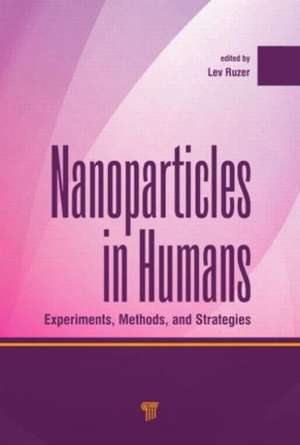Nanoparticles in Humans: Experiments, Methods, and Strategies
Editat de Lev S. Ruzeren Limba Engleză Hardback – 9 dec 2016
This book presents new ideas and methods to measure the surface area and local deposition of nanoparticles in the lungs and the true value of respirators. It proposes a nanoparticle dosimetric road map that can be used as a general strategy for the assessment of the dose, which is the most important physical cause of adverse effects on health in the case of nanoparticle exposure. The book suggests the use of 1 nm radioactive particles, called unattached activity of radon progeny, as a safe experimental tool for nanoparticle studies, including human studies. It discusses the problems related to the general strategy of risk assessment in nanoparticle exposure and concrete parameters related to dosage. The ideas presented in this book help close the gaps in our knowledge of aerosols in the nanometer range and improve our understanding of nanoparticle behavior in the air and in the human body.
Preț: 561.88 lei
Preț vechi: 754.96 lei
-26% Nou
Puncte Express: 843
Preț estimativ în valută:
107.52€ • 117.15$ • 90.60£
107.52€ • 117.15$ • 90.60£
Comandă specială
Livrare economică 02-16 aprilie
Doresc să fiu notificat când acest titlu va fi disponibil:
Se trimite...
Preluare comenzi: 021 569.72.76
Specificații
ISBN-13: 9789814463164
ISBN-10: 9814463167
Pagini: 152
Ilustrații: 32
Dimensiuni: 152 x 229 x 15 mm
Greutate: 0.35 kg
Ediția:1
Editura: Jenny Stanford Publishing
Colecția Jenny Stanford Publishing
ISBN-10: 9814463167
Pagini: 152
Ilustrații: 32
Dimensiuni: 152 x 229 x 15 mm
Greutate: 0.35 kg
Ediția:1
Editura: Jenny Stanford Publishing
Colecția Jenny Stanford Publishing
Public țintă
Academic and PostgraduateCuprins
Introduction. Radon and Health. Radon progeny; Spectrometry, Theory, Measurement, Emanating Samples of Short-Lived Nuclei with Constant Activity. Unattached Activity of Radon Progeny. Measurement of the Activity in the Lung of Miners. Assessment of Nanoparticle Surface Area by Measuring Unattached Fraction of Radon Progeny. Unattached Radon Progeny as an Experimental Tool. Exposure and Dose: Health Effect Studies. Conclusion.
Notă biografică
Lev S. Ruzer (1922–2014) was a researcher in the Indoor Environment Department, Environment Energy Technologies Division, at the Lawrence Berkeley National Laboratory, USA. He received his education in the former USSR and began his scientific career with research on dose assessment in animals exposed to radon and its decay products. On the basis of this theoretical and experimental work, he obtained his degree as a candidate of physicomathematical sciences (equivalent to a PhD) in 1961 from the Moscow Engineering Physics Institute. From 1961 to 1979, he was the founder and chair of the Aerosol Laboratory at the Institute of Physical-Technical and Radiotechnical Measurements, Moscow. The set of installations developed under his supervision for generating and measuring different types of aerosols was certified as the State Standard of Aerosols in the former USSR. This work did not have an equivalent at the time. His book on radioactive aerosols came out in 1968. Dr. Ruzer arrived in the United States in 1987 and joined the Lawrence Berkeley National Laboratory in 1989. He published more than 130 papers, edited 2 books, authored 3 books, and had 3 patents to his credit. He was on the editorial boards of several international journals.
Descriere
This book uniquely uses graphs and diagrams to build an understanding of the methods for measuring the surface area and local deposition of nanoparticles in lungs and the effectiveness of respirators in case of nanoparticles exposure. It begins by discussing radon and health. It reviews spectrometry and measurement of nanoparticle activity in the lungs. It discusses the assessment of nanoparticle surface area by measuring unattached fraction of radon progeny, explores the unattached radon progeny as an experimental tool, and discusses the impact of dosage on health effects.
